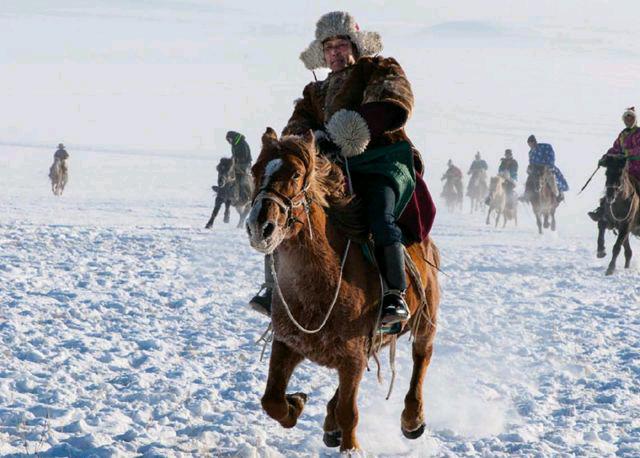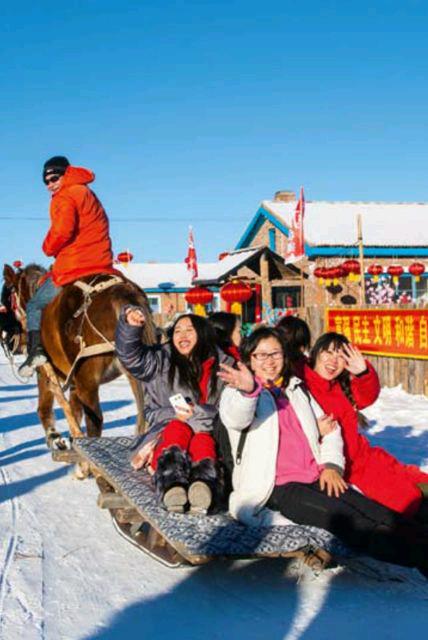Braving the Wrath of Winter
by+Zou+Yi+and+Dong+Jiajing
As the Chinese New Year draws near, some are praying for a white New Year despite the fact that snowfall has been rarer than usual this winter in the majority of the country due to higher temperatures. For those looking to brave the wrath of winter, Inner Mongolia Autonomous Region, one of the coldest places in the country, is an ideal destination. At the end of 2014, the second “Pole of Cold” Festival was held there.
Genhe: Greeting from the Coldest Place
A city at the northernmost tip of Inner Mongolia, Genhe is noted for its extreme cold in winter. Located at latitude 52 degrees north, the city isnt the northernmost place in China, but its geographical position at the northern foot of the Greater Khingan Mountains makes it the coldest place in the country. There, the temperature often drops below -50 degrees Celsius in winter. The lowest temperature ever recorded was -58. Genhe is also home to the countrys coldest village, Lengji (“Pole of Cold”) Village.
On December 24, 2014, as Westerners celebrated Christmas Eve, more than 300 guests, tourists and journalists from around the country joined locals from Genhe for the opening of the second China “Pole of Cold” Festival.
Compared to the first “Pole of Cold”Festival in 2013, the 2014 event provided more surprises and fun for visitors. In addition to traditional snow activities such as reindeer pulling sleighs, snowmobiling, and tubing, tourists could also gain close contact with local culture.
Despite the extremely cold weather, visitors felt warmth and hospitability from locals. In Lengji Village, tourists could enjoy organic homemade food and wine, sleep on firewood-heated brick beds, and ride sleighs dragged by huskies or horses. Tourists could also experience distinctive shamanic culture while enjoying the fantastic winter scenery of primitive forests. In the snow-blanketed village, tourists enjoyed a white Christmas when Santa Claus arrived. Visitors who successfully reached the Pole of Cold were awarded a certificate.
Genhe is also a must-see for those interested in close contact with Santas ride: reindeer. The Ewenki tribe in the citys Aoluguya Township is dubbed Chinas last hunting tribe, and locals herd more than 1,200 reindeer. In Ewenki language, Aoluguya means “place with lush trees.” The township is home to the countrys largest sub-zero coniferous forest. Genhe is also home to renowned Hanma Nature Reserve and Yikesama National Forest Park.

Hulun Buir: Ice and Snow Nadam
When Hulun Buir is mentioned, most probably imagine herds of cattle grazing on vast grassland. In fact, Hulun Buir Grass- land is particularly beautiful when carpeted by white snow during winter. There, the 2014 China Ice and Snow Nadam Fair kicked off atop the vast expanse of white in Hulun Buirs Old Barag Banner.
Nadam means “games” or “entertainment” in Mongolian. Nadam fairs were developed by Mongolian ancestors to celebrate the nomadic harvest. The primary activities of the fair include archery, horse racing, and wrestling. Previously, Nadam fairs were only held in July or August, the most beautiful seasons for grasslands. In recent years, with the increasing popularity of grassland tourism, the fairs have also been held in winter.
For the 2014 Ice and Snow Nadam Fair, nearby herders dressed in festive costumes rode horses or camels to the venue. The Nadam fair began with the spear-welcoming ceremony, which was born to pray for the welfare of domestic animals as well as happiness and health of families. At the opening ceremony of the Nadam fair, 300 herders in various ethnic costumes proved a sight to behold. Then, 32 players staged a special soccer match atop the snow.
The opening ceremony of the Nadam fair ended with a fire worship ritual. For Mongolians, fire is sacred and symbolizes prosperity and blessings. Accompanied by the matouqin (a stringed Mongolian instrument), local herders reached torches into the sacred fire in the center of the venue to light them. With the snow-covered grassland as the stage, they performed Barag folk dances together. Their song and dance fueled passion for the chilly winter.
Mordaga: From Logging to Eco Park
The town of Mordaga is found deep in forests of the northern Greater Khingan Mountains. Its name, literally “mount horse for an expedition,” is said to have been coined by Genghis Khan. When he rallied his army in todays Mordaga, Genghis Khan shouted “Mordaga!” and embarked on his expedition to unify Mongolia. When he returned victorious, the place was named Mordaga.
Nearly 95 percent of Mordagas land is covered by forests. The primary indigenous tree is the Dahurian larch, but white and black birches can also be found. Its abundant forest resources make the town an important timber producer in China. On an area of 48 hectares, Mordaga Timber Yard has two railways and five roads used to transport timber. It is the largest of its kind in the country.
However, backing the local economy through logging has proved unsustainable. As early as the 1990s, the local forestry bureau had already proposed a plan to develop forest-themed ecological tourism. On August 10, 2000, Mordaga National Forest Park opened, marking a significant step in the restructuring of its economic development.
Deep in the Greater Khingan Mountains, the forest park is noted for its high latitude and vastness, as well as well-preserved primitive ecosystem. The dense forests are complemented by running streams and snow-capped mountains. Especially in winter, its beauty is stunning.
Mordaga National Forest Park is still young after a history of only a dozen years. However, it is already widely known as the countrys largest and northernmost frigidtemperate forest park with the greatest biodiversity. While fulfilling its function of forest management and maintenance, the park provides tourism programs such as rafting, angling, boating, camping, skiing, and sleighing. Its tourist flow has increased by 25 percent each year. Mordaga has transformed from a logging base into a destination for eco-tourism.
China Pictorial2015年2期
